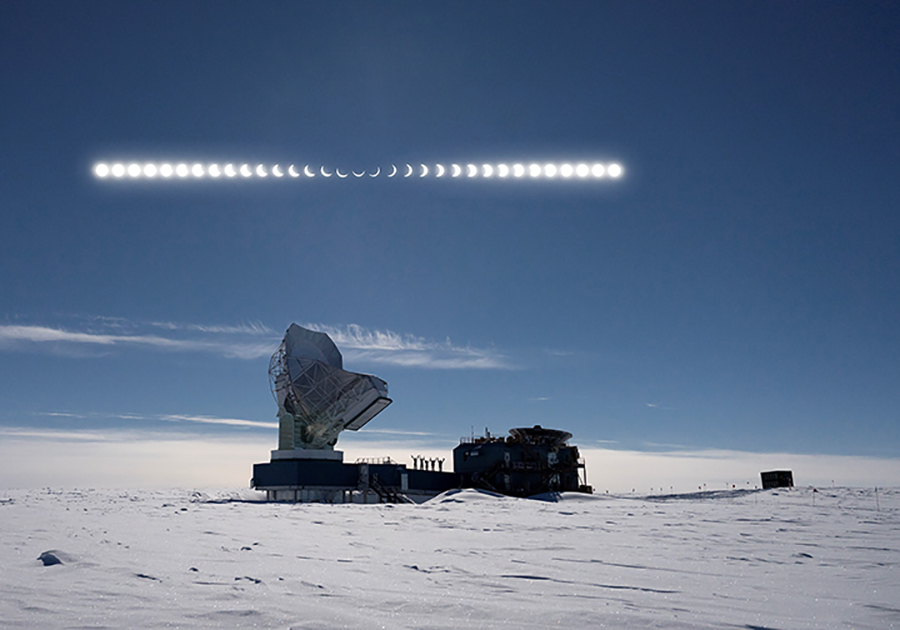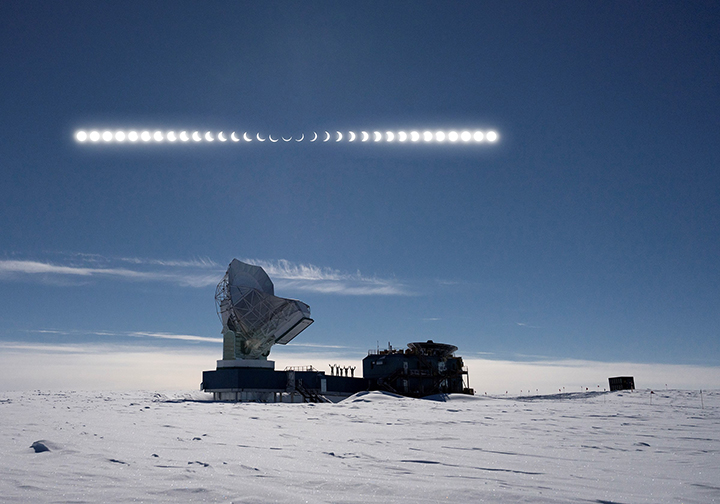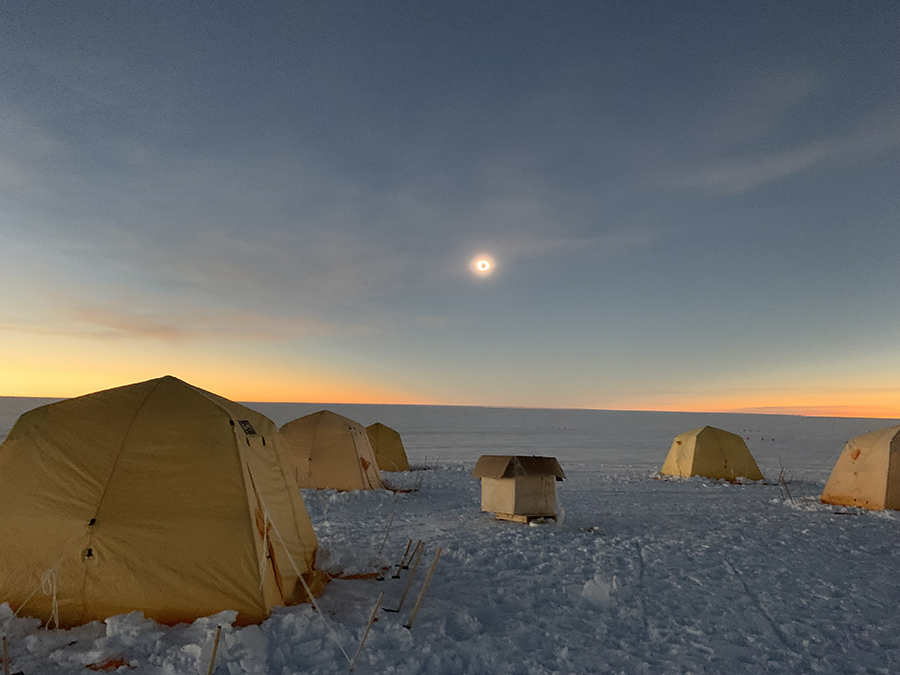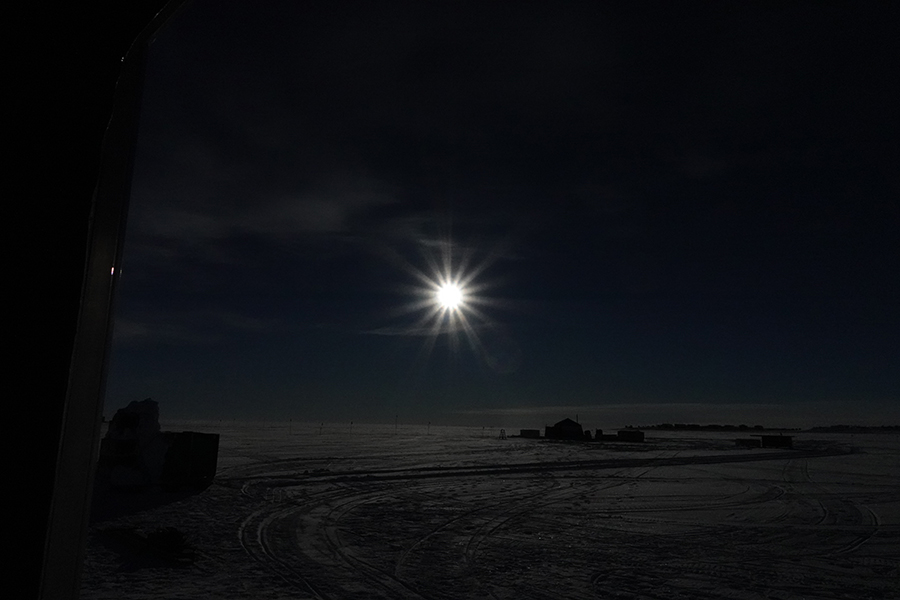Six stunning photos from the Antarctic solar eclipseFortuitous weather conditions allowed Antarcticans to watch the eclipse in fullPosted March 07, 2022
A total solar eclipse passed over Antarctica on December 4, 2021, a rare and exciting celestial event for the southernmost continent. The eclipse was a sight to behold for the few who witnessed it, but it was also a natural experiment for researchers studying how electricity flows through Earth's upper atmosphere. Here are six unforgettable photos of the eclipse and a glimpse of the science to come. 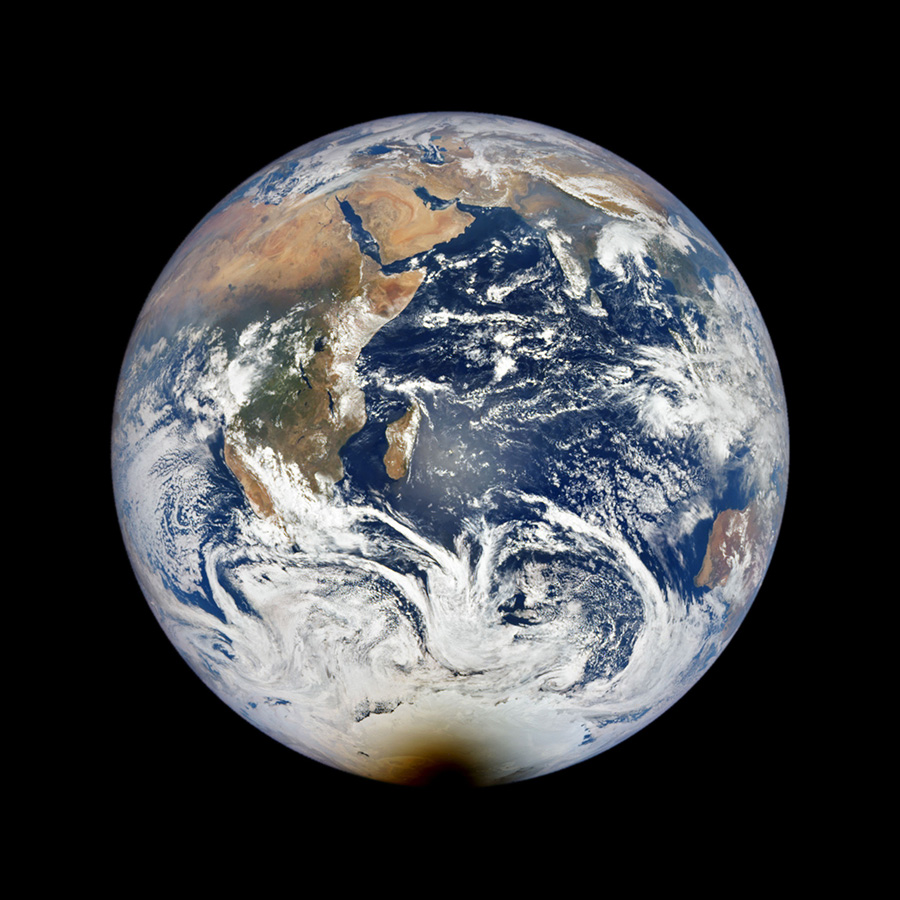
Photo Credit: NASA Earth Observator/EPIC/DSCOVR
A view of the December 4, 2021 total solar eclipse over Antarctica as seen by the EPIC camera on the DSCOVR satellite.
The view from spaceThis first image shows the Moon's shadow covering Antarctica from space. The image was taken by the Earth Polychromatic Imaging Camera (EPIC) aboard NASA's Deep Space Climate Observatory (DSCOVR) satellite. The DSCOVR satellite, which launched in 2015, observes Earth from 1.5 million kilometers away, at a gravitationally stable point between Earth and the Sun. The last eclipse over Antarctica before this one was in 2003, so this is the first opportunity DSCOVR had to capture an image of an Antarctic eclipse. The view from the South PoleEclipses over Antarctica are rare, and because the continent is so large only a small number of people were in the path of totality for December's eclipse. Residents at Amundsen-Scott South Pole Station saw only a partial eclipse, but astronomy graduate student Aman Chokshi, who is part of the South Pole Telescope team, put together this composite image of the eclipse as seen from the South Pole. A photo of the eclipse was taken about every four minutes. The image also shows how at Earth's poles, the Sun circles the horizon rather than rising and setting every day. The South Pole Telescope and BICEP array are seen in the foreground. The path of totalityU.S. Antarctic Program researchers and support staff at West Antarctic Ice Sheet (WAIS) Divide, a field camp in West Antarctica, were in the path of totality and experienced near-complete darkness during the eclipse. Weather in Antarctica is unpredictable and often cloudy, but luckily for those at WAIS Divide, skies were clear and conditions were perfect for snapping these photos. These next three images from WAIS Divide show the progressing darkness over the continent. Carpenter Dan Shea expressed how fortunate he feels that circumstances aligned just right for him to view the eclipse. “To have our flight make it through on the day of the eclipse after weeks of weather delays, and then to have clear skies in the evening, were both very lucky,” he said. Field safety coordinator Mike Roberts was also excited to experience totality at WAIS Divide. “To find myself on a rare blue sky evening wearing eclipse glasses and witnessing the totality of a full solar eclipse in remote Western Antarctica was incredible,” he said. “In a time interval of less than two minutes the sky dramatically darkened, the temperature dropped and as the Moon totally eclipsed the Sun, the horizon was lit by a stunning sunset, with glowing orange and red hues. Bizarrely, this rapidly transitioned into an equally brilliant sunrise. Everyone at WAIS Divide was stunned by their good fortune to witness this celestial event.” A penguin's day in the (partial) sunScientists were busily conducting research at an Adélie penguin colony on Ross Island on the day of the eclipse, but ecologist Annie Schmidt snapped this amazing photo of a male Adélie penguin silhouetted by the crescent Sun. The male is vocalizing, with his head held high and flippers outstretched. Adélie penguins frequently vocalize to communicate with one another. This photo was taken at the Cape Crozier colony, one of the largest Adélie colonies in Antarctica. 
Photo Credit: Annie Schmidt/Point Blue Conservation Science
A male Adelie penguin vocalizes during the partial solar eclipse.
The science to comeThe eclipse was a natural experiment for researchers studying electrical currents in Earth's upper atmosphere. This was their first opportunity to observe the detailed changes in electrical flow that happen during an eclipse from both the Northern and Southern hemispheres. Space physicists Mike Hartinger and Shane Coyle are part of an international team of researchers who are analyzing data collected during the eclipse. Luckily, there weren't any solar flares or other geomagnetic disturbances during the eclipse that could have altered the space environment over Antarctica, so the researchers' data collection went well and they are now in the early phases of analysis. According to Hartinger, the atmospheric measurements collected from instruments around the continent may shed light on why there are differences between the two hemispheres in how electricity flows in the upper atmosphere. This research is supported by the National Science Foundation, which manages the U.S. Antarctic Program. |
"News about the USAP, the Ice, and the People"



For USAP Participants |
For The Public |
For Researchers and EducatorsContact UsU.S. National Science FoundationOffice of Polar Programs Geosciences Directorate 2415 Eisenhower Avenue, Suite W7100 Alexandria, VA 22314 Sign up for the NSF Office of Polar Programs newsletter and events. Feedback Form |

